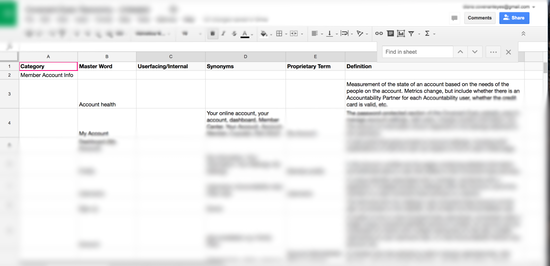Controlled Vocabulary and Taxonomy
|
Problem
The company had a large, uncontrolled and undocumented vocabulary. In more than one instance, a single term had several meanings or a single entity was referenced by several terms. A project was created to identify and document the vocabulary with the goal to create a taxonomy. My Role I served as a UX Researcher and Information Architect. I conducted interviews, confirmed term definitions, helped differentiate between the Controlled Vocabulary and Taxonomy work, met with vendors, and initiated work on the Knowledge Organization System. |
UX Disciplines: Content Strategy, Information Architecture, User Research, Writing for UX.
Deliverables: Facilitation, User Interviews, Secondary Research, collaboratively-developed Taxonomy, Various other documentation.
Approach
The team met with individuals from all company departments. Participating in hands-on research, participants wrote terms and grouped the terms with terms other departments used. It was messy, but it provided a large group of valuable terms.
We conducted interviews with key areas of word groupings: Services, Education, Support, and Accounts. More terms surfaced. Terms were grouped roughly by SaaS categories: Product/Service Development, Operations, Marketing/Sales, Finance/Admin, Customer Support. We documented preferred terms, synonyms, definitions and notes about the terms in spreadsheets.
Over the course of several months, we identified and defined over 900 terms, several with multiple meanings.
Grouping the terms into service areas specific to the business, we whittled the list down to under 200 terms.
A new team was formed to structure a taxonomy for the terms. The initial taxonomy was approved by the Content Strategist and members of Quality Assurance, User Experience, and Customer Support. Partnering with the Content Strategist, I met with Taxonomy tool vendors, although we declined to purchase a tool.
Results
The taxonomy will be used as the basis of a Knowledge Organization System, a tool by which business leaders may force relationships between concepts to uncover insights into the business. We still aren't convinced we need a taxonomy tool, but we realize that to answer key business questions information must be semantically linked.
Deliverables: Facilitation, User Interviews, Secondary Research, collaboratively-developed Taxonomy, Various other documentation.
Approach
The team met with individuals from all company departments. Participating in hands-on research, participants wrote terms and grouped the terms with terms other departments used. It was messy, but it provided a large group of valuable terms.
We conducted interviews with key areas of word groupings: Services, Education, Support, and Accounts. More terms surfaced. Terms were grouped roughly by SaaS categories: Product/Service Development, Operations, Marketing/Sales, Finance/Admin, Customer Support. We documented preferred terms, synonyms, definitions and notes about the terms in spreadsheets.
Over the course of several months, we identified and defined over 900 terms, several with multiple meanings.
Grouping the terms into service areas specific to the business, we whittled the list down to under 200 terms.
A new team was formed to structure a taxonomy for the terms. The initial taxonomy was approved by the Content Strategist and members of Quality Assurance, User Experience, and Customer Support. Partnering with the Content Strategist, I met with Taxonomy tool vendors, although we declined to purchase a tool.
Results
The taxonomy will be used as the basis of a Knowledge Organization System, a tool by which business leaders may force relationships between concepts to uncover insights into the business. We still aren't convinced we need a taxonomy tool, but we realize that to answer key business questions information must be semantically linked.
